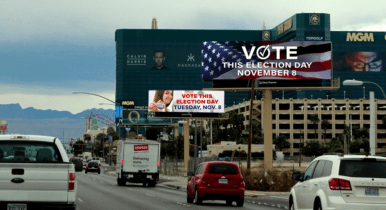Digital Out Of Home Expands Measurement, Reach

The sell-side in the digital out of home space has some reason to be excited about 2024. For one, the inventory has grown considerably and, like CTV/OTT, now boasts the kind of reach that previously didn’t exist a cycle or two ago.
“The beauty of it is it’s everywhere,” said Mike Hauptman, founder of AdLib Media Group, which offers political clients a programmatic DSP with a digital OOH connection. “It’s now in every major grocery store, even in smaller communities. “[The screens] are pervasive, they’re in the back of every taxi, every Uber, every, you know, kind of trucks are coming online as LED trucks.”
Americans have proved that they’re not averse to interacting with screens in places where they haven’t been before. But the added benefit to DOOH is that it’s increasingly measurable.
Hauptman noted that QR codes are now more prevalent on these types of creative, which offer campaigns and groups a click-through rate plus, say, the answers to polling questions.
“We’re seeing that [QR codes] become not necessarily the standard, but certainly adopted at a much higher rate for all of our digital out-of-home placements than they have historically,” Hauptman said. “There’s also some additional capabilities on the measurement side that are a bit more sophisticated that leverage location data.
“Even without the click, even without that QR code, [marketers can] understand, at the user level, proximity to a message and being able to tie that later to some action on the site.
“It’s almost like a view-through conversion without having to have that action take place directly on the call to action. So I think that’s also super compelling to an advertiser who [is] doing QR codes — even if they are complimentary.”



